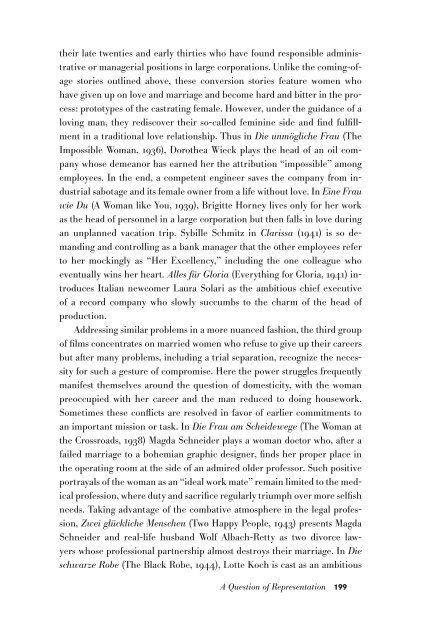Create successful ePaper yourself
Turn your PDF publications into a flip-book with our unique Google optimized e-Paper software.
their late twenties and early thirties who have found responsible administrative<br />
or managerial positions in large corporations. Unlike the coming-ofage<br />
stories outlined above, these conversion stories feature women who<br />
have given up on love and marriage and become hard and bitter in the process:<br />
prototypes of the castrating female. However, under the guidance of a<br />
loving man, they rediscover their so-called feminine side and find fulfillment<br />
in a traditional love relationship. Thus in Die unmögliche Frau (The<br />
Impossible Woman, 1936), Dorothea Wieck plays the head of an oil company<br />
whose demeanor has earned her the attribution “impossible” among<br />
employees. In the end, a competent engineer saves the company from industrial<br />
sabotage and its female owner from a life without love. In Eine Frau<br />
wie Du (A Woman like You, 1939), Brigitte Horney lives only for her work<br />
as the head of personnel in a large corporation but then falls in love during<br />
an unplanned vacation trip. Sybille Schmitz in Clarissa (1941) is so demanding<br />
and controlling as a bank manager that the other employees refer<br />
to her mockingly as “Her Excellency,” including the one colleague who<br />
eventually wins her heart. Alles für Gloria (Everything for Gloria, 1941) introduces<br />
Italian newcomer Laura Solari as the ambitious chief executive<br />
of a record company who slowly succumbs to the charm of the head of<br />
production.<br />
Addressing similar problems in a more nuanced fashion, the third group<br />
of films concentrates on married women who refuse to give up their careers<br />
but after many problems, including a trial separation, recognize the necessity<br />
for such a gesture of compromise. Here the power struggles frequently<br />
manifest themselves around the question of domesticity, with the woman<br />
preoccupied with her career and the man reduced to doing housework.<br />
Sometimes these conflicts are resolved in favor of earlier commitments to<br />
an important mission or task. In Die Frau am Scheidewege (The Woman at<br />
the Crossroads, 1938) Magda Schneider plays a woman doctor who, after a<br />
failed marriage to a bohemian graphic designer, finds her proper place in<br />
the operating room at the side of an admired older professor. Such positive<br />
portrayals of the woman as an “ideal work mate” remain limited to the medical<br />
profession, where duty and sacrifice regularly triumph over more selfish<br />
needs. Taking advantage of the combative atmosphere in the legal profession,<br />
Zwei glückliche Menschen (Two Happy People, 1943) presents Magda<br />
Schneider and real-life husband Wolf Albach-Retty as two divorce lawyers<br />
whose professional partnership almost destroys their marriage. In Die<br />
schwarze Robe (The Black Robe, 1944), Lotte Koch is cast as an ambitious<br />
A Question of Representation 199

















